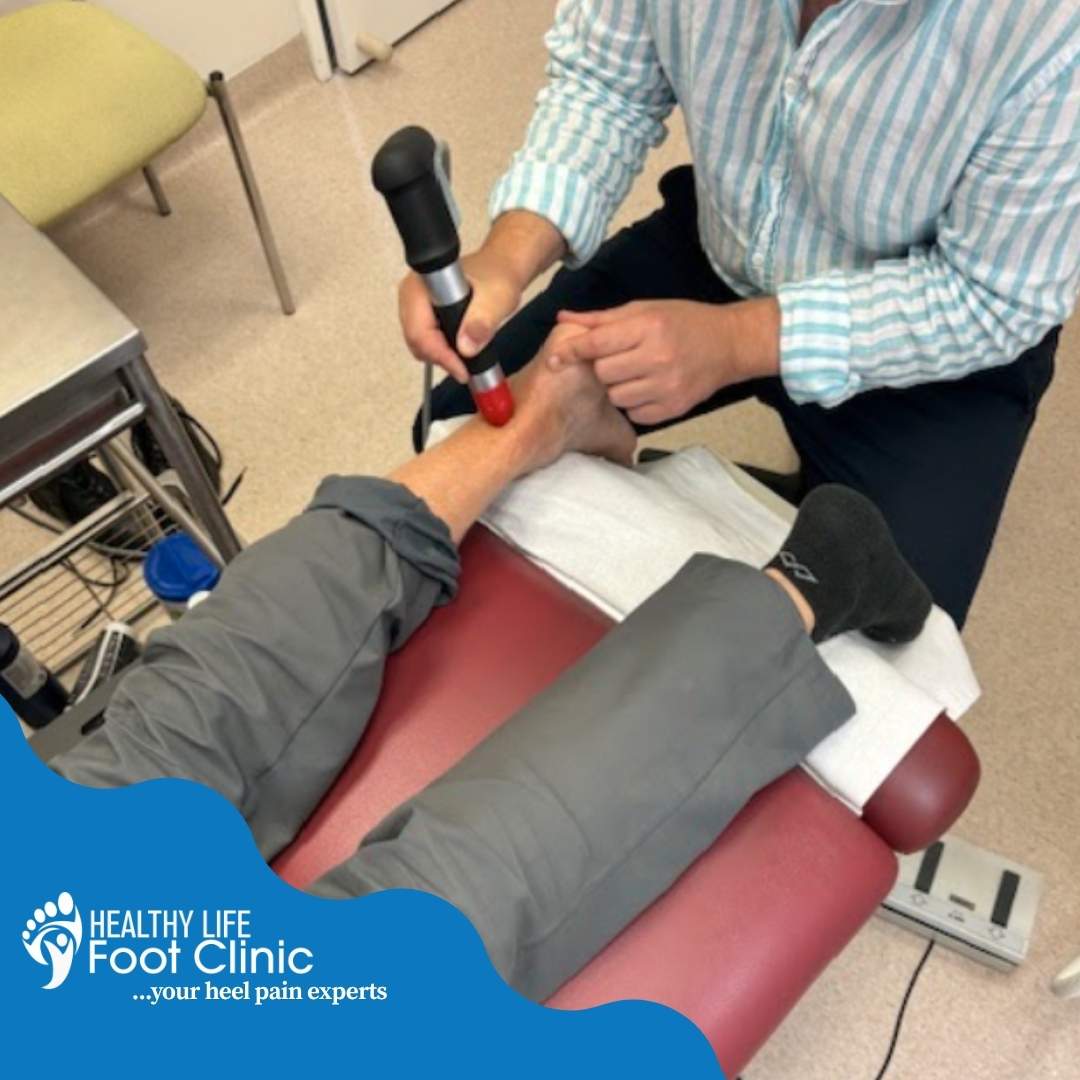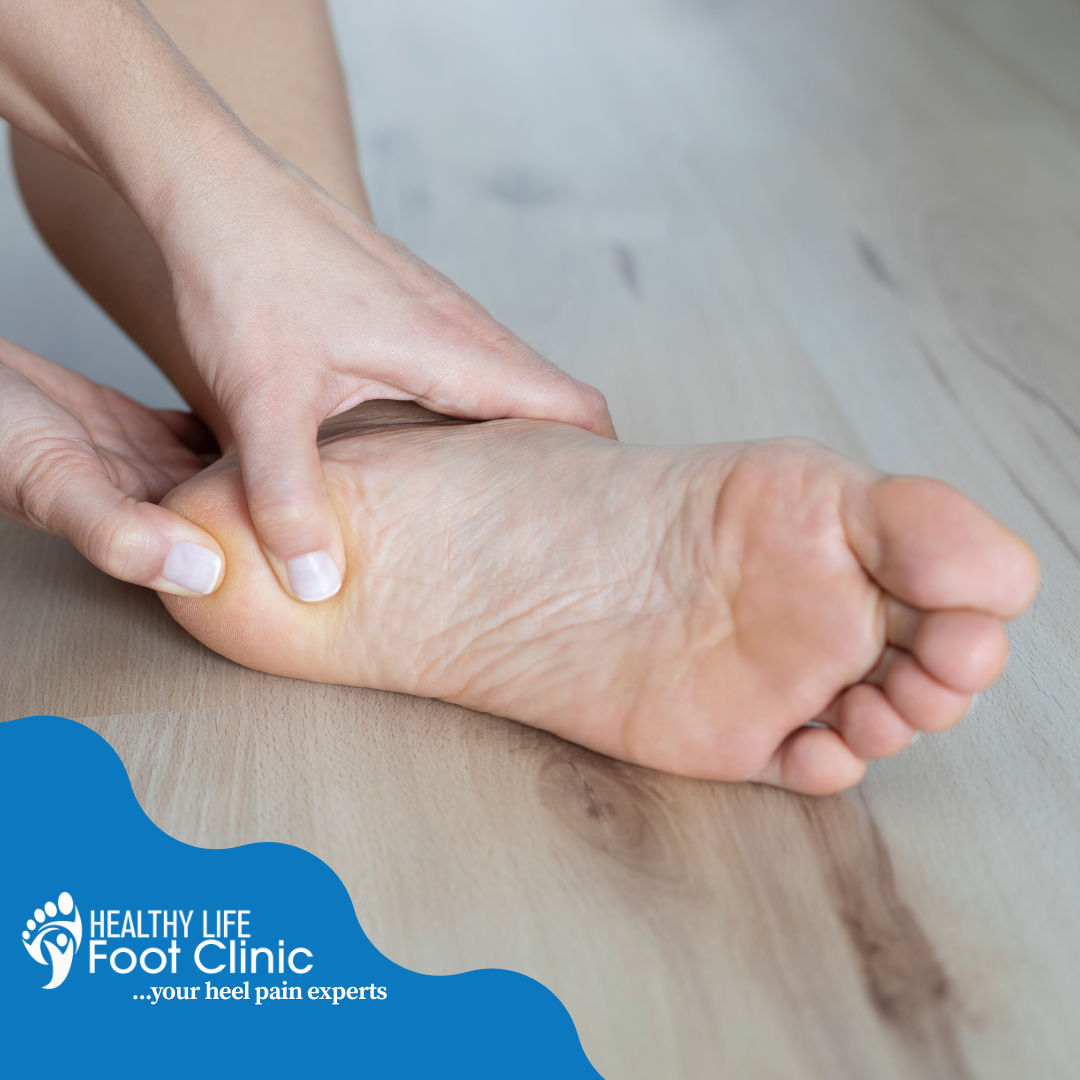What is Plantar Fasciitis?
Do you ever wake up after a good night’s sleep or get up after relaxing on the couch, only to find that your first few steps are painful?
Perhaps the discomfort arises after standing for extended periods?
Is the pain especially felt in your heel or arch of your foot?
If you answered ‘yes’ to any of these questions, you might be experiencing Plantar Fasciitis—a common condition that causes heel or arch pain, especially after periods of rest or inactivity.
The Plantar fascia is a thick band of tissue that connects your heel bone to your toes. This inflammation can lead to sharp heel pain, especially noticeable during your initial steps in the morning or after periods of rest.

Need a Podiatrist for Plantar Fasciitis?
Find Out More About Healthy Life Foot Clinic’s Care Guarantee
Contact Us or Book Online 24/7
What Causes Plantar Fasciitis?
Several factors can contribute to the development of plantar fasciitis:
-
Overuse and Repetitive Stress: Engaging in activities that place excessive strain on the feet, such as long-distance running, dancing, or occupations requiring prolonged standing, can overstretch the plantar fascia.
-
Foot Structure Abnormalities: Individuals with flat feet, high arches, or abnormal walking patterns may experience uneven weight distribution, increasing stress on the plantar fascia.
-
Improper Footwear: Wearing shoes lacking adequate arch support or cushioning can fail to absorb shock effectively, leading to increased tension on the plantar fascia.
-
Sudden Increases in Physical Activity: Rapidly intensifying exercise routines without proper conditioning can overload the plantar fascia.
-
Tight Calf Muscles or Achilles Tendons: Limited flexibility in these areas can affect foot mechanics, placing additional stress on the plantar fascia.
-
Weight Gain or Obesity: Excess body weight increases the load on the plantar fascia, heightening the risk of inflammation.
-
Aging: The plantar fascia naturally loses elasticity with age, making it more susceptible to injury.
-
Occupational Hazards: Jobs that involve standing or walking on hard surfaces for extended periods can contribute to the development of plantar fasciitis.

Need a Podiatrist for Plantar Fasciitis?
Find Out More About Healthy Life Foot Clinic’s Care Guarantee
Contact Us or Book Online 24/7
What are the Symptoms of Plantar Fasciitis?
The most common symptom of plantar fasciitis is a sharp, stabbing pain in the bottom of the heel. This pain is often most severe with the first steps in the morning or after periods of rest. As you move around, the pain may decrease but can return after long periods of standing or after exercise.
The pain is often more intense in the morning, potentially causing a limp or hobble after prolonged sitting or resting. Additionally, the pain may intensify following extended periods of walking, standing, or physical activity. In more severe cases, mild swelling or tenderness in the heel area might also be observed.
Need a Podiatrist for Plantar Fasciitis?
Find Out More About Healthy Life Foot Clinic’s Care Guarantee
Contact Us or Book Online 24/7
What is the best treatment for Plantar Fasciitis?
At Healthy Life Foot Clinic our podiatrists have seen and successfully treated hundreds of cases of plantar fasciitis with the use of some pretty cutting edge technology and techniques. All of our treatment and management plans are individually tailored to each patient, but some of the more common methods involve:
- Specific Plantar Fasciitis exercises to stretch and encourage blood flow to the affected area
- Foot mobilisation to allow more movement of joints in the foot and ankle and to encourage healing
- Custom made orthotics to maintain correct foot structure and minimise the likelihood of the issue reoccuring
- Low-dye strapping of the affected foot to provide some initial support
- Advise on activity or training modification
- Help you find the right shoes to wear
- Shock wave therapy (ESWT) in chronic heel pain cases
- Advise on appropriate night bracing (if needed)
- Work with you to make sure the problem doesn’t return
- Low level (“cold”) laser therapy to reduce inflammation especially when associated with arthritis
Ordering an X-ray and/or ultrasound scan to find out exactly what’s wrong can be necessary in some situation but in most cases the diagnosis can be made clinically following a physical examination.
Need a Podiatrist for Plantar Fasciitis?
Find Out More About Healthy Life Foot Clinic’s Care Guarantee
Contact Us or Book Online 24/7
The primary focus is on addressing the root cause of the issue and minimising load on the plantar fascia. This approach accelerates recovery and reduces the likelihood of recurrence.
Once pain subsides, a structured rehabilitation program can begin, emphasising progressive strengthening exercises, appropriate support, and strategies to prevent future injury.
Thankfully, the prognosis for plantar fasciitis is excellent, and in more than 99% of cases, conservative management is successful. However, the sooner you start treating the problem the better. Putting up with the pain by prolonging appropriate treatment intervention only makes recovery harder by allowing it to become a more chronic issue.
Where can I get help for Plantar Fasciitis in Adelaide?
If any of this sounds familiar and you think you may have plantar fasciitis and would like a professional opinion from one of our podiatrists, give us a call or book online to make an appointment.
Need a Podiatrist for Plantar Fasciitis?
Find Out More About Healthy Life Foot Clinic’s Care Guarantee
Contact Us or Book Online 24/7


